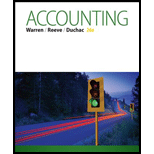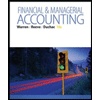
1.
Bonds Payable: Bonds payable are referred to long-term debts of the business, issued to various lenders known as bondholders, generally in multiples of $1,000 per bond, to raise fund for financing the operations.
Discount on bonds payable: It occurs when the bonds are issued at a low price than the face value.
Installment note: It is a debt in which the borrower is required to pay equal periodic payments to the lender based on the term of the note.
To Journalize: The entries to record the transactions.
1.
Explanation of Solution
| Date | Accounts and Explanation | Post Ref. | Debit ($) |
Credit ($) |
| 2016 | Cash | 62,817,040 | ||
| July 1 | Premium on Bonds Payable (1) | 7,817,40 | ||
| Bonds Payable | 55,000,000 | |||
| (To record issue of bonds at premium) | ||||
| October 1 | Cash | 450,000 | ||
| Notes Payable | 450,000 | |||
| (To record issue of 6% notes for cash) | ||||
| December 31 | Interest Expense | 9,000 | ||
| Interest Payable | 9,000 | |||
| (To record interest accrued on installment note) | ||||
| December 31 | Interest Expense (4) | 2,084,148 | ||
| Premium on Bonds Payable (2) | 390,852 | |||
| Cash (3) | 2,475,000 | |||
| (To record semiannual interest payment and amortization on bonds) |
Table (1)
| Date | Accounts and Explanation | Post Ref. | Debit ($) |
Credit ($) |
| 2017 | Interest Expense (4) | 2,084,148 | ||
| June 30 | Premium on Bonds Payable (2) | 390,852 | ||
| Cash (3) | 2,475,000 | |||
| (To record semiannual interest payment and amortization on bonds) | ||||
| September 30 | Interest Expense | 27,000 | ||
| Interest Payable | 9,000 | |||
| Notes Payable | 61,342 | |||
| Cash | 97,342 | |||
| (To record the annual payment on note) | ||||
| December 31 | Interest Expense | 7,773 | ||
| Interest Payable | 7,773 | |||
| To record interest accrued on installment note) | ||||
| December 31 | Interest Expense (4) | 2,084,148 | ||
| Premium on Bonds Payable (2) | 390,852 | |||
| Cash (3) | 2,475,000 | |||
| (To record semiannual interest payment and amortization on bonds) |
Table (2)
| Date | Accounts and Explanation | Post Ref. | Debit ($) |
Credit ($) |
| 2018 | Bonds Payable | 55,000,000 | ||
| June 30 | Premium on Bonds Payable | 6,253,632 | ||
| Gain on Redemption of Bonds (6) | 4,603,632 | |||
| Cash (5) | 56,650,000 | |||
| (To record redemption of bonds) | ||||
| September 30 | Interest Expense | 23,320 | ||
| Interest Payable | 7,773 | |||
| Notes Payable | 66,249 | |||
| Cash | 97,342 | |||
| (To record the annual payment on note) |
Table (3)
Working notes:
Calculate discount on bonds payable.
Calculate premium on bonds payable semiannually.
Calculate the amount of cash interest.
Calculate the interest expense on the bond.
Calculate cash paid to redeem the bonds.
Compute gain on the redemption of the bonds payable.
2016:
- On July 1, Cash is debited as it increased the asset. Premium on bonds payable is credited as it increased the liability. Bonds payable is credited as it increased the liability.
- On October 1, Cash is debited as it increased the asset. Notes payable is credited as it increased the liability.
- On December 31, interest expense is debited as it decreases the equity value. Interest payable is credited as it increased the liability.
- On December 31, interest expense is debited as it decreases the equity value. Premium on bonds payable is debited as it decreased the liability. Cash is credited as it decreased the asset.
2017:
- On June 30, interest expense is debited as it decreases the equity value. Premium on bonds payable is debited as it decreased the liability. Cash is credited as it decreased the asset.
- On September 30, interest expense is debited as it decreases the equity value. Interest payable and notes payable are debited as it decreased the liability. Cash is credited as it decreased the asset.
- On December 31, interest expense is debited as it decreases the equity value. Interest payable is credited as it increased the liability.
- On December 31, interest expense is debited as it decreases the equity value. Premium on bonds payable is debited as it decreased the liability. Cash is credited as it decreased the asset.
2018:
- On June 30, Bonds payable is debited as it decreased liability. Premium on bonds payable is debited as it decreased the liability. Gain on redemption of bonds is credited as it increases the equity value. Cash is credited as it decreased the asset.
- On September 30, interest expense is debited as it decreases the equity value. Interest payable and notes payable are debited as it decreased the liability. Cash is credited as it decreased the asset.
2 (a)
The amount of interest expense in 2016.
2 (a)
Explanation of Solution
Determine the amount of interest expense in 2016.
Hence, the amount of total interest expense in 2016 is $2,093,148.
2 (b)
To Determine: the amount of interest expense in 2017.
2 (b)
Explanation of Solution
Hence, the amount of total interest expense in 2017 is $4,203,069.
3.
The carrying amount of bonds as of December 31, 2017.
3.
Explanation of Solution
Determine the carrying amount of bonds as of December 31, 2017.
| Particulars | Amount ($) |
| Initial carrying amount of bonds | 62,817,040 |
| Premium amortized on December 31, 2016 | (390,852) |
| Premium amortized on June 30, 2017 | (390,852) |
| Premium amortized on December 31, 2017 | (390,852) |
| Carrying amount of bonds, December 31, 2017 | 61,644,484 |
Table (4)
The carrying amount of bonds as of December 31, 2017 is $61,644,484
Want to see more full solutions like this?
Chapter 14 Solutions
Bundle: Accounting, Loose-Leaf Version, 26th + LMS Integrated for CengageNOW, 2 terms Printed Access Card
- Last Chance Mine (LCM) purchased a coal deposit for $2,918,300. It estimated it would extract 18,950 tons of coal from the deposit. LCM mined the coal and sold it, reporting gross receipts of $1.24 million, $13 million, and $11 million for years 1 through 3, respectively. During years 1-3, LCM reported net income (loss) from the coal deposit activity in the amount of ($11,400), $550,000, and $502,500, respectively. In years 1-3, LCM extracted 19,950 tons of coal as follows: (1) Tons of Coal 18,950 Depletion (2) Basis (2)(1) Rate $2,918,300 $154.00 Tons Extracted per Year Year 1 4,500 Year 2 8,850 Year 3 6,600 Note: Leave no answer blank. Enter zero if applicable. Enter your answers in dollars and not in millions of dollars. b. What is LCM's percentage depletion for each year (the applicable percentage for coal is 10 percent)? Percentage Depletion Year 1 Year 2 Year 3 $ 0arrow_forwardCan you please solve this accounting issue without use Ai?arrow_forwardBrown Company estimates that monthly sales will be as follows. January $100,000 February 150,000 March 180,000 Historical trends indicate that 40 percent of sales are collected during the month of sale, 50 percent are collected in the month following the sale, and 10 percent are collected two months after the sale. Brown's accounts receivable balance as of December 31 totals $80,000 ($72,000 from December's sales and $8,000 from November's sales). The amount of cash Brown can expect to collect during the month of January is?arrow_forward
- Please need answer the financial accounting questionarrow_forwardprovide answer of this General accounting questionarrow_forwardOn January 1, 2024, Packard Corporation leased equipment to Hewlitt Company. The lease term is 9 years. The first payment of $457,000 was made on January 1, 2024. Remaining payments are made on December 31 each year, beginning with December 31, 2024. The equipment cost Packard Corporation $2,956,548. The present value of the lease payments is $2,986,412. The lease is appropriately classified as a sales-type lease. Assuming the interest rate for this lease is 9%, what will be the balance reported as a liability by Hewlitt in its balance sheet on December 31, 2025?arrow_forward
- What is the cost of goods sold on these financial accounting question?arrow_forwardNicole organized a new corporation. The corporation began business on April 1 of year 1. She made the following expenditures associated with getting the corporation started: Expense Date Amount Attorney fees for articles of incorporation February 10 $ 40,500 Stock issuance costs March 1-March 30 wages March 1-March 30 rent April 1-May 30 wages Note: Leave no answer blank. Enter zero if applicable. March 30 6,550 March 30 2,850 April 1 May 30 24,000 16,375 b. What amount of the start-up costs and organizational expenditures may the corporation immediately expense in year 1 (excluding the portion of the expenditures that are amortized over 180 months)? Start-up costs expensed Organizational expenditures expensedarrow_forwardGeneral accountingarrow_forward
 Financial Accounting: The Impact on Decision Make...AccountingISBN:9781305654174Author:Gary A. Porter, Curtis L. NortonPublisher:Cengage Learning
Financial Accounting: The Impact on Decision Make...AccountingISBN:9781305654174Author:Gary A. Porter, Curtis L. NortonPublisher:Cengage Learning Financial AccountingAccountingISBN:9781305088436Author:Carl Warren, Jim Reeve, Jonathan DuchacPublisher:Cengage LearningPrinciples of Accounting Volume 1AccountingISBN:9781947172685Author:OpenStaxPublisher:OpenStax College
Financial AccountingAccountingISBN:9781305088436Author:Carl Warren, Jim Reeve, Jonathan DuchacPublisher:Cengage LearningPrinciples of Accounting Volume 1AccountingISBN:9781947172685Author:OpenStaxPublisher:OpenStax College Financial & Managerial AccountingAccountingISBN:9781285866307Author:Carl Warren, James M. Reeve, Jonathan DuchacPublisher:Cengage Learning
Financial & Managerial AccountingAccountingISBN:9781285866307Author:Carl Warren, James M. Reeve, Jonathan DuchacPublisher:Cengage Learning College Accounting, Chapters 1-27AccountingISBN:9781337794756Author:HEINTZ, James A.Publisher:Cengage Learning,
College Accounting, Chapters 1-27AccountingISBN:9781337794756Author:HEINTZ, James A.Publisher:Cengage Learning, Excel Applications for Accounting PrinciplesAccountingISBN:9781111581565Author:Gaylord N. SmithPublisher:Cengage Learning
Excel Applications for Accounting PrinciplesAccountingISBN:9781111581565Author:Gaylord N. SmithPublisher:Cengage Learning





